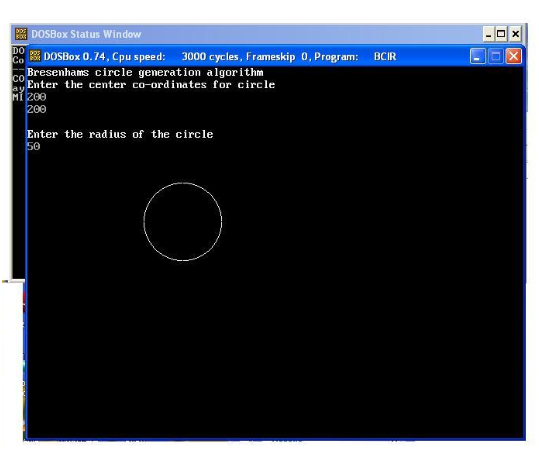Bresenham’s circle algorithm is an efficient way to draw a circle using only integer calculations. It eliminates the need for floating-point arithmetic and is widely used in computer graphics.
Below is the implementation of Bresenham’s circle drawing algorithm using C++ and the graphics.h library. This program takes user input for the circle’s center and radius, then uses the algorithm to plot the circle.
#include<iostream.h> // Header file for input-output operations
#include<conio.h> // Header file for console input/output functions
#include<stdlib.h> // Standard library for utility functions
#include<graphics.h> // Header file for graphics functions
#include<dos.h> // Header file for delay functions
// Function prototype for Bresenham's circle algorithm
void circ_bre(int x,int y,int rad);
// Function prototype for displaying pixels of the circle
void display(int,int,int,int);
void main()
{
int gd = DETECT, gm, x, y, r;
initgraph(&gd, &gm, "c:\\tc\\bgi"); // Initialize graphics mode
cleardevice(); // Clear the graphics screen
cout << "Bresenham's Circle Generation Algorithm ";
cout << "\nEnter the center coordinates for the circle: ";
cin >> x >> y;
cout << "\nEnter the radius of the circle: ";
cin >> r;
circ_bre(x, y, r); // Call function to draw the circle
getch(); // Wait for user input before closing the graphics window
closegraph(); // Close graphics mode
}
// Function implementing Bresenham's circle algorithm
void circ_bre(int x, int y, int rad)
{
float dp; // Decision parameter
int x1, y1;
x1 = 0; // Initializing x1 and y1 for circle drawing
y1 = rad;
dp = 3 - 2 * rad; // Initial decision parameter
while (x1 <= y1)
{
if (dp <= 0)
dp += (4 * x1) + 6; // Update decision parameter if inside the circle
else
{
dp += 4 * (x1 - y1) + 10; // Update decision parameter if outside the circle
y1--; // Move towards the center
}
x1++;
display(x1, y1, x, y); // Plot the symmetric points
}
}
// Function to plot symmetric pixels of the circle
void display(int x1, int y1, int x, int y)
{
putpixel(x1 + x, y1 + y, WHITE); // Plot points in all 8 octants
putpixel(x1 + x, y - y1, WHITE);
putpixel(x - x1, y1 + y, WHITE);
putpixel(x - x1, y - y1, WHITE);
putpixel(x + y1, y + x1, WHITE);
putpixel(x + y1, y - x1, WHITE);
putpixel(x - y1, y + x1, WHITE);
putpixel(x - y1, y - x1, WHITE);
}
Explanation
- Initializing Graphics Mode:
initgraph(&gd, &gm, "c:\\tc\\bgi");initializes the graphics mode using the BGI (Borland Graphics Interface) path.cleardevice();clears the screen before drawing.
- User Input:
- The program takes user input for the center coordinates
(x, y)and the radiusrof the circle.
- The program takes user input for the center coordinates
- Bresenham’s Algorithm Logic:
- Uses a decision parameter
dpto determine the next pixel position. - Adjusts
dpbased on whether the pixel is inside or outside the ideal circle boundary. - Exploits the symmetry of a circle by plotting 8 symmetric points for each computed
(x1, y1)pair.
- Uses a decision parameter
- Displaying Pixels:
- The
display()function usesputpixel()to plot the circle’s points in all 8 octants, ensuring a smooth and complete circle.
- The
Output

Bresenham’s circle algorithm is a fundamental technique in computer graphics, especially for low-level graphics rendering. Understanding this algorithm helps in grasping rasterization techniques used in modern rendering engines.
If you’re working with Turbo C++ or any other old graphics library, ensure that the graphics drivers are set up correctly before running the program.
Happy Coding! 🚀
